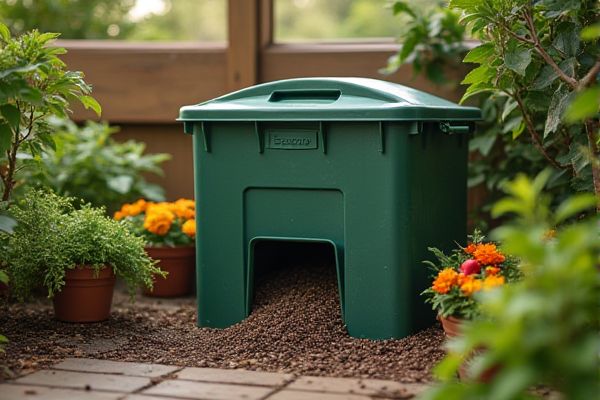
Compact composters efficiently process kitchen scraps and garden waste into nutrient-rich soil in a smaller footprint, while worm bins use red wigglers to break down organic material more quickly and with less odor. Explore the rest of this article to discover which composting method suits your lifestyle and gardening needs best.
Table of Comparison
| Feature | Compact Composter | Worm Bin |
|---|---|---|
| Composting Method | Traditional aerobic decomposition | Vermicomposting using red worms |
| Ideal Waste | Vegetable scraps, garden waste, paper | Fruit and vegetable scraps, coffee grounds |
| Odor | Minimal if balanced | Low to none, smells earthy |
| Space Requirement | Medium; suitable for small gardens | Compact; ideal for indoor/small spaces |
| Composting Time | 2-4 months | 1-2 months |
| Output | Nutrient-rich compost | High-quality worm castings |
| Maintenance | Turn regularly, monitor moisture | Feed worms, maintain moisture and temperature |
| Pests | Possible; needs pest control | Minimal if managed properly |
| Cost | Moderate initial investment | Low to moderate |
Introduction to Compact Composters and Worm Bins
Compact composters efficiently break down organic waste in small spaces using aerobic decomposition, ideal for urban gardeners with limited room. Worm bins utilize vermiculture, where red wiggler worms consume food scraps and produce nutrient-rich castings, enhancing soil fertility naturally. Your choice depends on whether you prefer a low-maintenance, odor-controlled system or faster composting with live worms actively processing waste.
How Do Compact Composters Work?
Compact composters utilize insulated, airtight chambers to accelerate the decomposition of organic waste by maintaining optimal moisture and temperature levels. These units rely on aerobic bacteria to break down food scraps rapidly, often incorporating turning mechanisms or trays to enhance airflow and expedite composting. In contrast, worm bins depend on red wiggler worms to consume organic material, producing nutrient-rich vermicompost through biological digestion rather than heat-driven decomposition.
Understanding the Worm Bin System
The worm bin system is a compact composting method that utilizes red wigglers (Eisenia fetida) to efficiently break down organic waste into nutrient-rich vermicompost. Unlike traditional composters, worm bins operate effectively indoors or in small spaces, maintaining controlled moisture, temperature, and airflow for optimal worm activity. This system accelerates decomposition while producing high-quality castings beneficial for soil health and plant growth.
What Materials Can You Compost in Each?
Compact composters effectively process fruit and vegetable scraps, coffee grounds, eggshells, and garden waste like leaves and small branches, making them suitable for a wide range of organic materials. Worm bins specialize in decomposing softer kitchen scraps such as fruit and vegetable peels, coffee grounds, and paper products but should avoid meat, dairy, and oily foods to maintain worm health. Understanding what materials work best in each system helps you maximize composting efficiency and produce nutrient-rich soil amendments.
Space and Location Requirements
Compact composters require minimal space, making them ideal for small balconies or patios, and are designed for outdoor use with good ventilation. Worm bins are also space-efficient but often fit better indoors, such as under sinks or in closets, due to their need for temperature control and protection from extreme weather. Both systems optimize organic waste recycling but differ in location flexibility based on environmental needs.
Maintenance and Ease of Use
Compact composters require minimal maintenance with occasional turning and monitoring moisture levels, making them suitable for beginners seeking low-effort organic waste management. Worm bins demand more attention, including feeding schedules, temperature regulation, and harvesting worm castings, ideal for users wanting nutrient-rich compost. Both systems offer efficient decomposition but differ in the degree of hands-on involvement and care complexity.
Composting Speed and Output Quality
Compact composters typically accelerate the composting process by maintaining higher temperatures, resulting in faster breakdown of organic material within weeks. Worm bins, while slower, produce nutrient-rich vermicompost with superior microbial content that enhances soil health and plant growth. Your choice depends on whether you prioritize rapid composting speed or the high-quality output associated with worm composting.
Odor and Pest Control Considerations
Compact composters use sealed containers and built-in aeration systems to minimize odors and deter pests effectively, making them suitable for small outdoor spaces. Worm bins rely on red wiggler worms to break down organic waste quickly, reducing odor through natural processing but require careful moisture and feeding management to prevent fly infestations. Both systems benefit from regular maintenance, but compact composters offer more robust pest control with fewer odor issues in urban environments.
Cost and Long-Term Value
A compact composter typically has a lower upfront cost but may require frequent maintenance and replacement, affecting long-term value. Worm bins have a higher initial investment but provide continuous, nutrient-rich vermicompost, enhancing soil health and reducing waste over time, which increases overall cost-effectiveness. Evaluating durability, maintenance needs, and compost quality helps determine the most valuable option for sustainable organic waste management.
Choosing the Right System for Your Needs
Compact composters excel in processing kitchen scraps and yard waste quickly, offering a space-efficient solution ideal for small gardens and balconies. Worm bins utilize red wiggler worms to break down organic matter into nutrient-rich vermicompost, perfect for indoor use and continuous compost production. Selecting the right system depends on available space, composting speed, and the volume and type of organic waste you generate.
 homyna.com
homyna.com